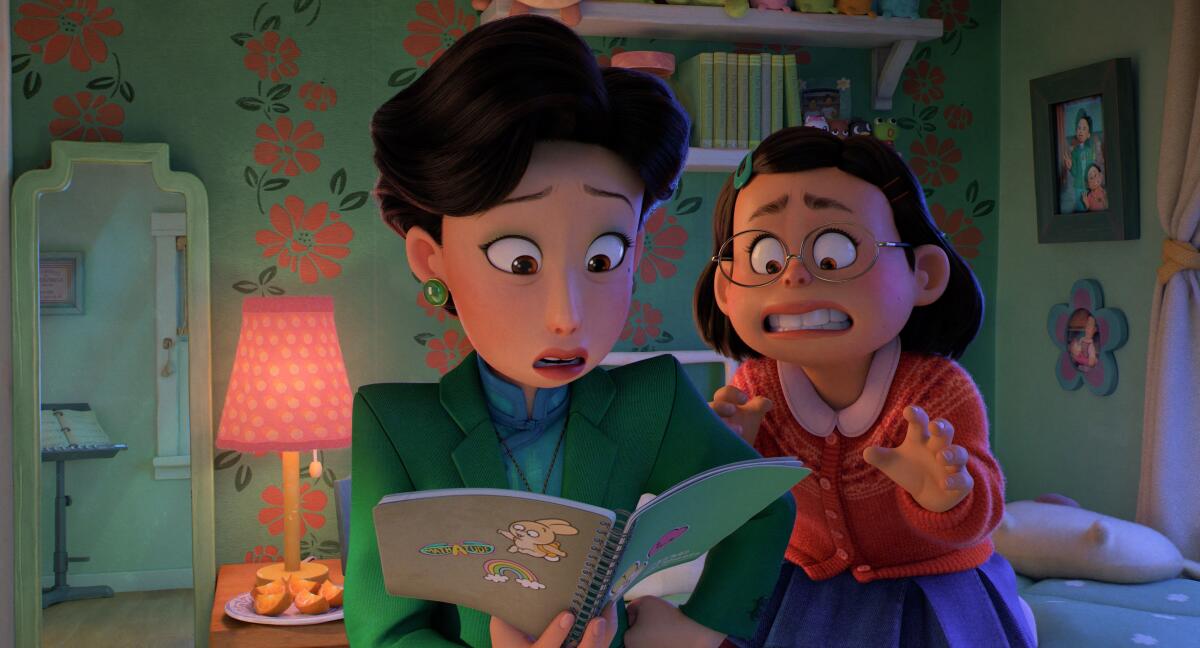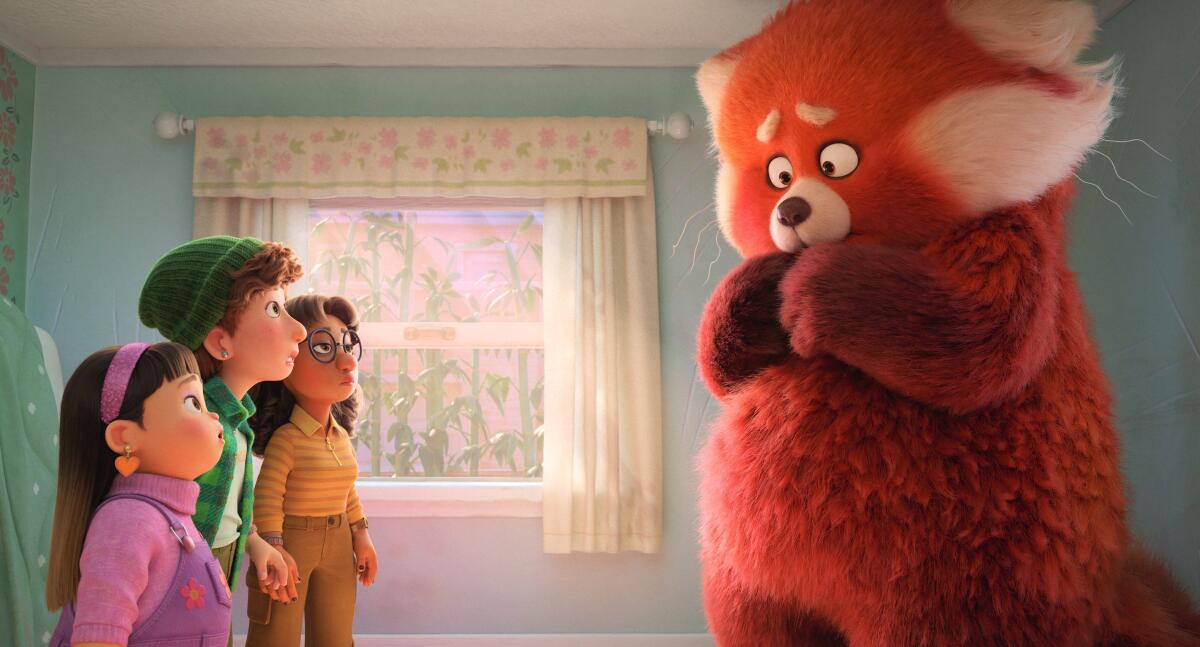Column: If you can’t relate to ‘Turning Red,’ you must not like good movies

- Share via
Here’s something I did not know about myself until I saw Domee Shi’s new Pixar movie “Turning Red”: Apparently I am a 13-year-old Chinese Canadian girl living in Toronto in the early 2000s.
I thought I was a middle-aged white woman of Irish descent currently living in Los Angeles, but what do I know? Not much, according to a male film critic who declared the Disney+ release to be so narrowly focused it would speak only to those in the exact same demographic as the main character, her family and her friends.
The main character being Mei Lee (winningly voiced by Rosalie Chiang), a 13-year-old Chinese Canadian girl living in Toronto.
Fortunately for the future of film as an art form, that critic, CinemaBlend managing director Sean O’Connell, is having a very bad week. The outrage sparked by his review and subsequent tweet assertion that those not in what he considers the “narrow” and “specific” target audience would, as he did, find the film “exhausting” — forced him and CinemaBlend to take down the review and issue an apology.
Interview with “Turning Red” director Domee Shi
It’s impossible to feel any sympathy for him, but there is value in seeing the prejudice that has squelched the careers of so many filmmakers and other artists so nakedly exposed.
For far too many cultural gatekeepers, the “universal audience” is still defined as white, male and, apparently, stupidly uninterested in stories about anyone who is not.
In case you thought filmmakers who were not white men were, you know, making this up, O’Connell’s review served as a reminder that they are not.
That someone would actually give voice to this ridiculous worldview, especially while reviewing a film that features Pixar’s first Asian lead, boggles the mind. Fortunately, readers and viewers literally would not let it stand, which makes the incident more hopeful than not.
Personal resonance should not be the standard of critical thought, but in the case of “Turning Red,” it seems impossible to me that anyone could fail to identify with Mei, her family and her friends. “Turning Red” is beautifully specific about Mei’s Asian heritage and community — much of the action takes place in the family temple — but at its heart are the agony and ecstasy of puberty. At 13, Mei discovers a welter of new emotions — rage, acute embarrassment, lust — that cause her unexpected transformation into a big fluffy red panda.

Unless I missed the robot revolution Hollywood is so fond of imagining, everyone on the planet experiences puberty in all its flushed, eardrum-throbbing, stomach-churning, “just leave me alone” horror/glory. And many of us would have been grateful to have that inner turmoil made physically manifest, especially in the form of a big red cuddle-monster.
With her swings between wild self-confidence and stumbling self-doubt, Mei is immediately recognizable to anyone who has ever been or met a 13-year old girl. She strides through the school hallways like a boss, only to crumble under taunts. In several instances, her mother, Ming (Sandra Oh), seems to go out of her way to mortify her daughter, which may be a reflection of a certain kind of Asian mother but also reflects how every 13-year old feels about any public sighting of the dreaded “Mo-om.”
Mei is also, obviously, a girl. And so her puberty involves the discussion of menstruation and, in two scenes, the presence of (gasp) menstrual pads. When Mei hides her brand-new panda self in the bathroom, Ming assumes that “the red peony” has bloomed and produces, to hilarious and poignant effect, a Homeric list of sanitary pad options. (Ming makes many mistakes during the film but neglecting to stock up on feminine care supplies is not one of them.)
Pads on film are a first for any Pixar or Disney movie, which is kind of incredible when you consider that Disney has been in the princess-coming-of-age business for 85 years now. If nothing else, narratively normalizing a bodily function that affects more than half the world’s population makes “Turning Red” a cinematic revolution.
But the film is not actually about menstruation, it’s about emergence — young woman from child, individual from family, identity from relegation. And it isn’t just about Mei. Her friends, as a stand-in for all those generations that certain adults feel must be “protected” from the complex realities of human identity, are delighted by this new side of Mei, which they consider a bonus rather than a curse.
The mother-daughter tensions within a Chinese Canadian family fuel “Turning Red,” a charming feature debut from “Bao” director Domee Shi.
Mei’s mother, Ming, on the other hand, wants to quell the red panda, which she fears will ruin Mei’s life. (As a metaphor, that red panda has very broad shoulders.)
Unlike most mothers in the Disney/Pixar canon, however, Ming is neither absent nor part of the furniture. She is present and participatory, and she has her own emerging to do. My favorite scene, which may be a spoiler so feel free to skip ahead two paragraphs, is when Ming, furious over her daughter’s disobedience and sass, unleashes her own red panda.
Any mother who has engaged in a screaming tantrum-fight with a teenager over the importance of respect and maturity (“Don’t you use that language to me, goddammit” is something I have certainly said) will appreciate the sight of Ming’s mama panda on the loose. Puberty is tough on everyone, including and especially parents. No matter what their cultural background, mothers suffer most directly from the love/hate whiplash of adolescence, and their pain and confusion are just as real, though often quite frightening.
Like Shi’s Oscar-winning short “Bao,” “Turning Red” isn’t just a first for menstruation, or Chinese Canadians, or Asian communities, it’s a breakthrough for moms.
That could be one reason it resonated with me. Or perhaps it’s because “Turning Red” is, quite simply, a very good movie.
More to Read
Only good movies
Get the Indie Focus newsletter, Mark Olsen's weekly guide to the world of cinema.
You may occasionally receive promotional content from the Los Angeles Times.













